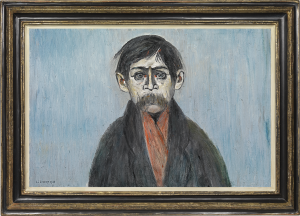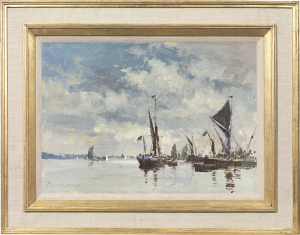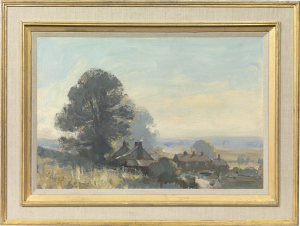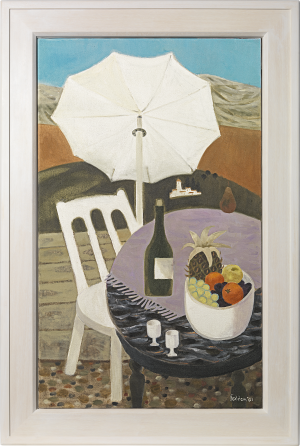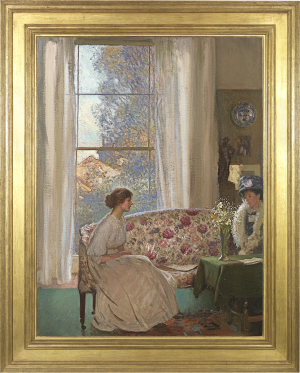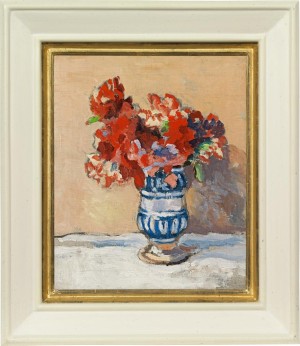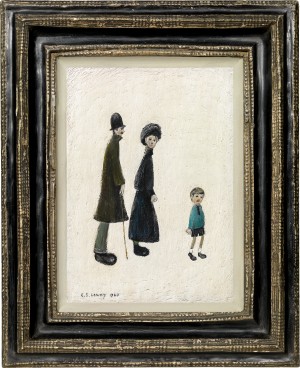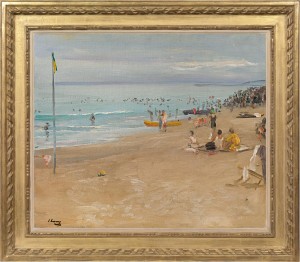Mary Fedden
Two pots of flowers
Oil on canvas: 12 x 24 (in) / 30.5 x 61 (cm)
Signed and dated lower right: Fedden 1992; signed and inscribed on a label attached to the stretcher: Mary Fedden / Durham Wharf / Hammersmith Terrace / W6 9TS / "2 Pots of Flowers".
This artwork is for sale.
Please contact us on: +44 (0)20 7493 3939.
Email us
MARY FEDDEN OBE RA PPRWA
Bristol 1915 - 2012 London
Ref: BZ 229
Two pots of flowers
Signed and dated lower right: Fedden 1992; signed and inscribed on a label attached to the stretcher: Mary Fedden / Durham Wharf / Hammersmith Terrace / W6 9TS / "2 Pots of Flowers". Also inscribed on the stretcher: On loan from…HORTON (RWA 1992)
Oil on canvas: 12 x 24 in / 30.5 x 61 cm
Frame size: 17 ½ x 29 ½ inches / 44.4 x 74.9 cm
Provenance:
Robert Elmer Horton MBE, MS, FRCS (1917-2003), possibly acquired directly from the artist, then by descent
Exhibited:
Bristol, Royal West of England Academy, 140th Annual Exhibition, 8th November -12th December 1992, no.184
In this richly coloured and boldly patterned flowerpiece, Mary Fedden places two glass tumblers with carefully selected short-stemmed, single blooms on a decorative cloth before a stormy sky. The narrow, horizontal format of the canvas brings the small, jewel-like bouquets into dramatic focus. On the left a rich, dark purple primula with golden centre is offset by three lavender blue periwinkle heads, with what might be white narcissus above. The bold combination of white and deep purple is echoed in the stripped fabric to the left, which, like the tempestuous sky in the background, adds theatricality and depth to the scene. The larger posy on the right shows three glorious crocus heads with orange/gold stamens next to two white primulas, their gold centres echoed in the diamond-patterned cloth on which they sit. To their left is the broad olive leaf with pale, variegated spots of a pulmonaria with the deep blue multi-flowered heads of the borage family above.
In an interview in The Artist in 1995, Fedden acknowledged ‘I really float from influence to influence...I found the early Ben Nicholson’s fascinating as were the paintings of his wife Winifred. I also admire the Scottish artist Anne Redpath and the French painter Henri Hayden.’ Fedden often composed her still lifes before a window or landscape, a device frequently used by Ben and Winifred Nicholson, as well as other members of the Seven and Five Society in the 1920s and 30s. Still life was a vehicle through which the artist could play with conventions, using a collection of much-loved curiosities, talismanic objects that became revisited subjects in her practice including teapots and jugs, lamps, bottles, fruits and plants to celebrate their familiarity. It is in the joyful symphony of colour and pattern orchestrated in this abundant arrangement that Fedden’s love for the genre is realised: ‘I come back from holiday with sketchbooks full of landscapes…and then I’m back to still life. It’s my real love.’[1]
Robert Elmer Horton was a consultant surgeon at the United Bristol Hospitals. Born in south London, he studied medicine at Guy’s Hospital and was awarded the MBE during the Blitz for outstanding courage in rescuing casualties from a bombed building. Sent to India and Burma, he commanded a frontline surgical unit in Burma and later led a surgical division at the General Hospital, Rangoon. He served for six years and became Colonel. He returned to Guy’s to complete his surgical training and was then appointed senior lecturer and consultant at Bristol Royal Infirmary, where he pioneered vascular surgery. His writings on the subject of post-traumatic vascular injuries brought international recognition. Besides his surgical career, he also studied painting in oils and frequently exhibited at the Royal West of England Academy, where Mary Fedden was President from 1984-88.[2]
[1] The artist cited in Christopher Andreae, Mary Fedden: Enigmas and Variations, Lund Humphries, Aldershot, 2007, p.118.
[2] See Royal College of Surgeons of England website / Plarr’s Lives of the Fellows: RCS: E000076.












